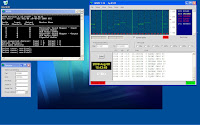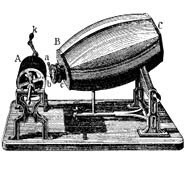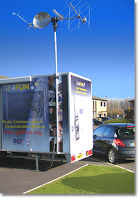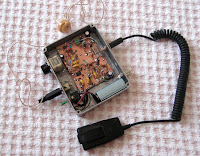
There was a MOST interesting note on the ARRL propagation report tonight:
"Noctilucent Clouds Return - As reported at spaceweather.com on June 1, the first noctilucent clouds (NLC) of the 2009 season were sighted over Russia on May 27. NLCs typically appear about 20 days prior to the summer solstice, increase quickly to a high summer level, and then disappear about 50 days after the summer solstice. These clouds are mostly a high latitude phenomenon, and are believed to be composed of ice crystals. VHF radars see very strong echoes from these clouds, and since they are at mesospheric heights (80 to 90 km), they are also known as polar mesosphere summer echoes (PMSE). These clouds are hypothesized by JE1BMJ and others to be responsible for 6m propagation across high latitudes (for example,
from the East Coast of North America to Japan) during the northern hemisphere summer. This mode of propagation has been dubbed Summer Solstice Short-path Propagation (SSSP). Check out page 34 of the February 2009 issue of WorldRadio Online (available free at
www.cq-amateur-radio.com/wr_back_issues.html) for a general discussion of PMSE and SSSP and for references in the technical literature. To reiterate, SSSP is still just a theory,
but the occurrences of QSOs appear to match the occurrence pattern of PMSE."
Now, there is also evidence (from radar returns) that microwave DX might be possible using the same noctilucent clouds, possibly allowing superb DX possibilities on 10GHz possibly even with low power.
This is a whole area of future ham research just waiting to be exploited. It may be one upside of global warming as these high altitude clouds are now more common than hitherto.
For more on these mesospheric clouds see
http://www.chiandh.me.uk/p/Noctilucent_cloud#Results
 DH5RAE (990kms away) logged my 5W into just the 10m band halo TXing WSPR on 30m a few minutes ago. So, the system is now fully working, despite the appalling antenna for 30m. Then in the next timeslot I was received by OH2BMH (1759kms away). WSPR is going to be one heck of a lot of fun on bands like 10m and 6m with QRP when the bands open up.
DH5RAE (990kms away) logged my 5W into just the 10m band halo TXing WSPR on 30m a few minutes ago. So, the system is now fully working, despite the appalling antenna for 30m. Then in the next timeslot I was received by OH2BMH (1759kms away). WSPR is going to be one heck of a lot of fun on bands like 10m and 6m with QRP when the bands open up. ing" I've now been received in 5 European countries at distances between 594 and 1759kms. The image on the left is of my WSPR log.
ing" I've now been received in 5 European countries at distances between 594 and 1759kms. The image on the left is of my WSPR log.















